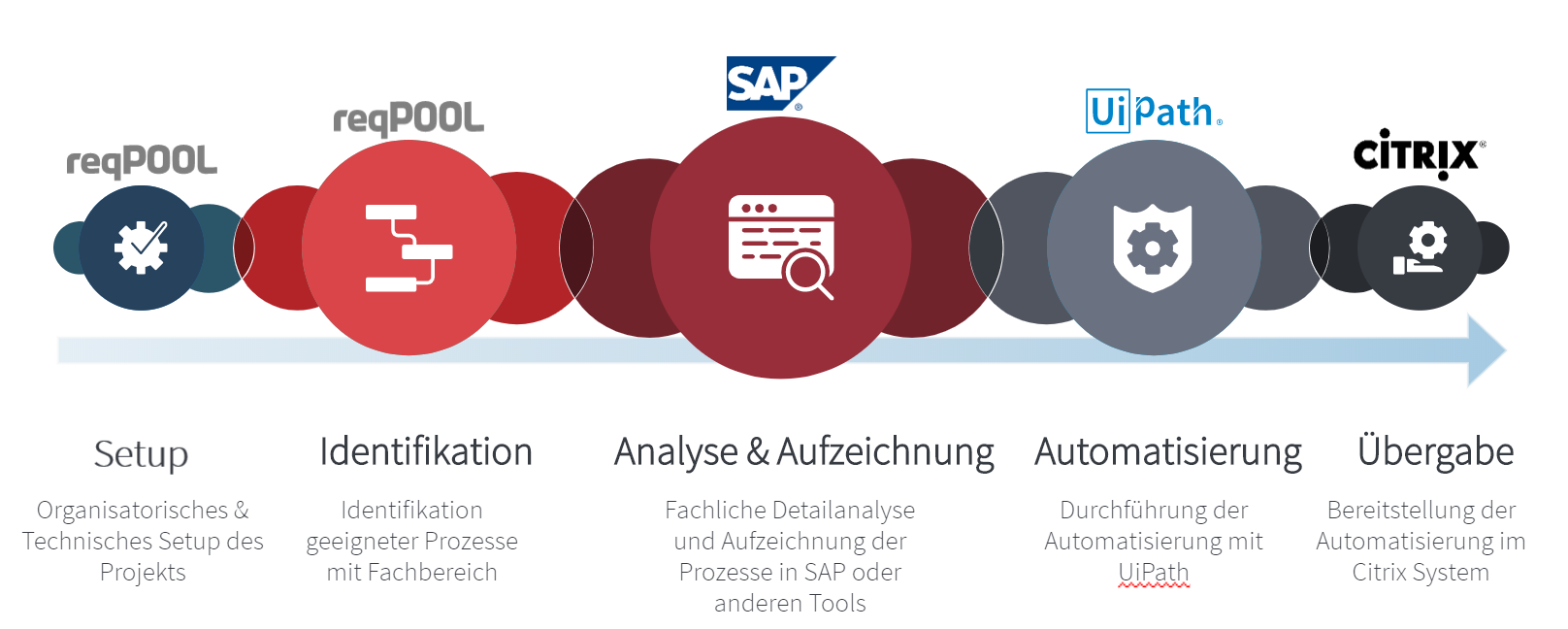RPA Robotic Process Automation
Insights» RPA Robotic Process Automation
Robotic Process Automation (RPA) is a topic that is receiving more and more attention in today’s business world. Process and process automation accompany companies and organizations on the path to digitization and increase market competitiveness through more efficient and faster process processes. However, employees and staff are often sceptical about the issue (for example, due to fears of job loss), which makes it difficult to introduce this technology in their own company. In this article, we want to shed more light on Robotic Process Automation and highlight the potential of this technology. We also give a brief insight into a typical RPA project with our customers.
Robotic Process Automation as a leading area in the global software market
Software robots are applications that mimic human interaction with user interfaces of software systems and thus carry out processes on their own. According to Gartner, sales in the Robotic Process Automation division grew by 63.1 percent in 2018, reaching a record high of 846 million dollars. Revenues are forecast to be USD 1.3 billion in 2019. This makes RPA technology the fastest growing segment in the global software market.
The biggest users of RPA are still banks, insurance companies and telecommunications companies, as old systems, so-called “legacy systems”, are often used here, the replacement of which involves enormous effort and high costs. In such cases, RPA plays an important interface function, for example, to transfer data from these legacy systems to new systems. RPA is a bridge technology that provides the benefits of digitalization at an early stage and provides financial support for the replacement of outdated systems in the medium term.
Large software companies such as IBM and SAP have also recognized the potential that RPA brings. They have started to partner with or purchase RPA providers to integrate their services into their solutions. This fact contributes to a further increase in awareness and acceptance of RPA in the market.
Process optimization and quality improvement through RPA
But what exactly are the benefits of using RPA for a company or organization?
To integrate an RPA tool into a company or organization, you don’t need to change the existing system landscape. The RPA software exists in addition to the existing systems and interacts with them. RPA is therefore a great transition solution for large software transfer projects, as the technology allows data to be transferred between two or more systems without having to implement a complicated interface.
Since the installation of RPA tools is usually fast and the automation of processes can be started quickly, one often achieves a quick return on investment. Depending on the complexity of the process and the know-how or capabilities of the automating person, the duration of the automation of simple processes including testing is only a few weeks.
Employees can be relieved by automating repetitive and lengthy processes and devoting themselves to more demanding tasks, such as improving the customer experience. The key word is quality improvement. This is achieved, for example, by reducing the number of erroneous inputs caused by humans and thus by reducing the operational risk. In addition, automated processes can be run more often and also overnight. For example, the robot could prepare an elaborate report every night to minimize risk, whereas an employee can only deal with the issue once a week due to lack of time.
Another advantage is the optimization of existing processes, which goes hand in hand with the use of RPA. The processes to be automated are subjected to a thorough analysis and documentation before the automation phase. The chances of optimization potentialbeing being uncovered here are high, as intensive lyrification is being dealt with processes that may not have been questioned for many years. The more efficient a process is made during the documentation phase, the faster and more efficient the automated process will run.
Rule-based and standardized – the most important eligibility criteria for automatable processes
In RPA Tools, most of the work performed by employees on a laptop or PC can be automated. Examples of automatable activities include mouse clicks, copy&paste activities, filling fields, comparing values or tables, or searching texts for specific values.
Nevertheless, there are processes that are better suited to automation than others. Processes suitable for automation are based on defined rules and are therefore repeatable. They follow a defined structure and involve relatively few exceptional cases. Processes that are based on human decisions and have all the characteristics, branches and exceptional cases are unsuitable for automation. Equally unsuitable are processes in which contact with customers or people in general plays a role, since software robots cannot react flexibly to input in the same way as artificial intelligences and only strictly follow the designed automated process flow. Furthermore, customers often prefer contact with real people rather than robots. Also, before an automation, the question must always be asked whether the process is not elsewhere optimizable or automatable. For example, processes that are very Excel-based could also be implemented with the use of macros.
Automatable processes can usually be found in all departments or departments of a company or organization. An example of a use case in IT would be the setup of a new user, in finance and controlling areas, for example, the preparation of reports from SAP tables can be automated. The update of personnel data or the processing of holiday requests are use cases from the HR area.
Success factor IT and business
The close cooperation between business and IT is essential in the area of RPA. In most cases, the organizational units and departments supply the processes, document them and hand over the documentation together with suitable test data to IT for the implementation and testing of the automated process. Depending on the RPA governance model, it is of course also possible for IT to provide an RPA platform and organizational units to carry out the automations themselves. Typically, however, automation takes place centralized in a department (usually IT) to avoid a proliferation of automated processes in the organization. In addition, the process must be maintained and adjusted regularly after automation should changes occur in the process flow. The establishment of a suitable communication channel between organizational units and IT is of great importance here in order to maintain the quality of the automated processes and to avoid errors at an early stage.

Insight into an RPA project
A typical RPA project with one of our energy customers relies on UiPath as a software solution for automation. However, before automation occurs, the first thing to do is to identify suitable (partial) processes. In addition to the frequency of execution, the duration of the process to be automated is also an important selection criterion. Often, the processes within an organization are poorly or poorly documented. It is therefore necessary to document the selected candidates professionally. In addition to branching the processes, errors are also considered, as well as screenshots of the participating applications are taken, so that at the end a very precise, comprehensive documentation of the process is available. This is subsequently implemented by our automation experts in UiPath. The robot is then deployed to the department in the customer’s system, such as a Citrix system with virtual workstations.
Summary
With the use of Robotic Process Automation in your organization, you not only drive digitization, but also generate significant benefits and consolidate your competitiveness in the market. By performing the automated processes more frequently, if desired, more frequently and error-free, you gain time for more demanding tasks and increase the satisfaction of your employees and customers. Process optimization is a topic that is closely linked to RPA. RPA projects thus offer the opportunity to achieve a significant increase in process quality.
At ReqPOOL, we help you successfully implement RPA projects by providing our experts with an interface function between business and IT and assisting with process analysis and documentation. Our experienced RPA experts are also happy to help with the initial implementation of documented processes and the development of RPA know-how in your organization.
Insights» RPA Robotic Process Automation
See more technical articles
Christian Buchegger
Germany: +49 (0) 30 84415801
Austria: +43 (0) 800 500122
E-Mail: office@reqpool.com
Get in touch
Arrange an appointment

Christian Buchegger
Germany: +49 (0) 30 84415801
Austria: +43 (0) 800 500122
E-Mail:office@reqpool.com

